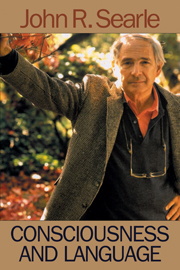Book contents
- Frontmatter
- Contents
- Introduction
- 1 The Problem of Consciousness
- 2 How to Study Consciousness Scientifically
- 3 Consciousness
- 4 Animal Minds
- 5 Intentionality and Its Place in Nature
- 6 Collective Intentions and Actions
- 7 The Explanation of Cognition
- 8 Intentionalistic Explanations in the Social Sciences
- 9 Individual Intentionality and Social Phenomena in the Theory of Speech Acts
- 10 How Performatives Work
- 11 Conversation
- 12 Analytic Philosophy and Mental Phenomena
- 13 Indeterminacy, Empiricism, and the First Person
- 14 Skepticism About Rules and Intentionality
- Name Index
- Subject Index
1 - The Problem of Consciousness
Published online by Cambridge University Press: 14 January 2010
- Frontmatter
- Contents
- Introduction
- 1 The Problem of Consciousness
- 2 How to Study Consciousness Scientifically
- 3 Consciousness
- 4 Animal Minds
- 5 Intentionality and Its Place in Nature
- 6 Collective Intentions and Actions
- 7 The Explanation of Cognition
- 8 Intentionalistic Explanations in the Social Sciences
- 9 Individual Intentionality and Social Phenomena in the Theory of Speech Acts
- 10 How Performatives Work
- 11 Conversation
- 12 Analytic Philosophy and Mental Phenomena
- 13 Indeterminacy, Empiricism, and the First Person
- 14 Skepticism About Rules and Intentionality
- Name Index
- Subject Index
Summary
What Is Consciousness?
Like most words, ‘consciousness’ does not admit of a definition in terms of genus and differentia or necessary and sufficient conditions. Nonetheless, it is important to say exactly what we are talking about because the phenomenon of consciousness that we are interested in needs to be distinguished from certain other phenomena such as attention, knowledge, and self-consciousness. By ‘consciousness’ I simply mean those subjective states of sentience or awareness that begin when one awakes in the morning from a dreamless sleep and continue throughout the day until one goes to sleep at night, or falls into a coma, or dies, or otherwise becomes, as one would say, ‘unconscious’.
Above all, consciousness is a biological phenomenon.We should think of consciousness as part of our ordinary biological history, along with digestion, growth, mitosis and meiosis. However, though consciousness is a biological phenomenon, it has some important features that other biological phenomena do not have. The most important of these is what I have called its ‘subjectivity’. There is a sense in which each person's consciousness is private to that person, a sense in which he is related to his pains, tickles, itches, thoughts and feelings in a way that is quite unlike the way that others are related to those pains, tickles, itches, thoughts and feelings. This phenomenon can be described in various ways. It is sometimes described as that feature of consciousness by way of which there is something that it's like or something that it feels like to be in a certain conscious state. If somebody asks me what it feels like to give a lecture in front of a large audience, I can answer that question.
Information
- Type
- Chapter
- Information
- Consciousness and Language , pp. 7 - 17Publisher: Cambridge University PressPrint publication year: 2002
Accessibility standard: Unknown
Why this information is here
This section outlines the accessibility features of this content - including support for screen readers, full keyboard navigation and high-contrast display options. This may not be relevant for you.Accessibility Information
- 3
- Cited by
